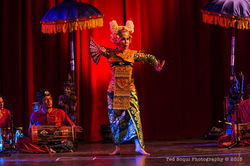
Gamelan
Gamelan is more or less equivalent with the English word for orchestra, a generic term for an ensemble; in this case associated with primarily gong chimes. The Burat Wangi gamelan comes from Indonesian traditional music, mainly from the islands of Java, Madura, Bali, and Lombok. The orchestras are designed, constructed and tuned to be played together as one singular unit. This means tuning, painting, and much more are all done together. Gamelan instrumentation consists largely of percussive instruments such as bronze gongs of many different sizes and metallophones, bamboo flutes, string instruments, and drums. An amazing diversity of musical ensembles and dance genres exists in these islands.
The number of players is determined by the type of ensemble. A small amount of players, ranging from 2 to 6 players, are required to perform Gender Wayang (Bali), Kecapi-Suling (West Java), and Gadhon (Central Java), while around 45 players or more are necessary to perform the stately ceremonial pieces of gamelan Gong Gede (Bali) and gamelan Sekaten (Java).



 |  |  |
|---|---|---|
 |  |  |
 |  |  |
 |  |
